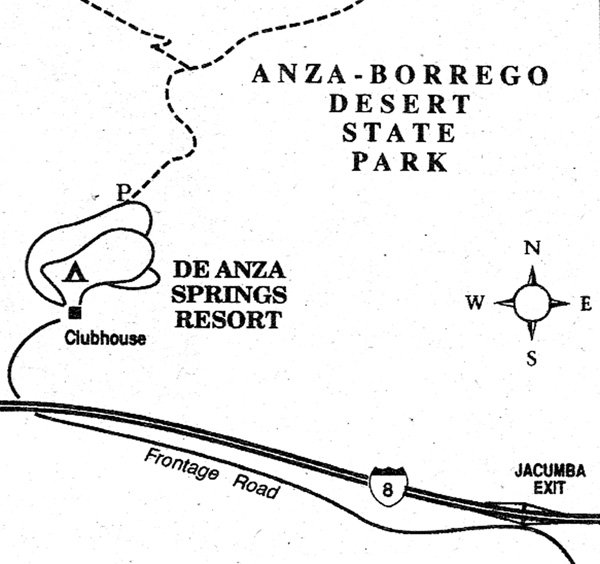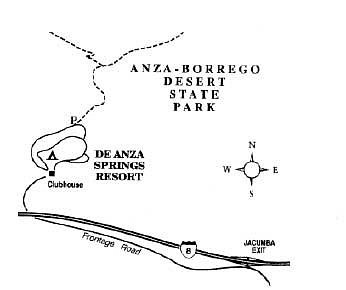 Facebook
Facebook
 X
X
 Instagram
Instagram
 TikTok
TikTok
 Youtube
Youtube

Drive an hour east on Interstate 8 from San Diego toward El Centro and you won't fail to be impressed by the enormous stacks of rounded boulders thrusting skyward over the high-desert landscape. How did these boulder piles get there? Are they the "sweepings of the world," as Padre Pedro Font characterized similar formations during his travels through Anza-Borrego on the 1775 Anza expedition? Or is there a more prosaic geologic explanation?
Here's a way to get up close and familiar with some of the boulder piles near I-8: Take the Jacumba exit off I-8, which is 75 miles east of Mission Valley. Turn sharply right (west) and follow a smoothly graded, unpaved frontage road two miles to the DeAnza Springs clothing-optional resort. The resort's 500 acres include recreational facilities plus scattered motorhomes and permanent residences amid a backdrop of boulder-studded hills. At the gate, tell the attendant (or use the intercom if no one's there) that you want to hike in the area, and ask permission to park. A fee of $5 per car is charged. You will be directed to park your car in the northeast corner of the resort property. Remember to observe the posted speed limit of 5 miles per hour inside the resort, which will help keep the dust down. (DeAnza Springs' phone number is 619-766-4301.)
From the parking area, a trail delineated by stones dips into a ditch, quickly veers left, and joins an old jeep road swinging north toward a number of interesting giant boulder piles. You soon pass through a gap in a wire fence marking your transition between the resort property and lands inside Anza-Borrego Desert State Park. The undulating hills and valleys ahead have been used for many years by the Sierra Club's San Diego chapter for outing-leader training and for navigation practice for students enrolled in the club's Wilderness Basics Course. You can stick with the jeep roads that lace the area or strike off in nearly any direction to climb amid the boulders.
So what's the deal with the boulders? Nothing more than subsurface and surface weathering of a rising mass of granitic rock. Groundwater infiltrates the joints (cracks or planes of weakness) in the rock mass well before any overlying layers of rock or soil have eroded away. Gaps open up as the rock is subject to slow but steady decomposition by physical forces and chemical processes. Further, the mineral grains on any sharp corner of a rock surface will tend to loosen and fall away easier, thus contributing to an overall rounding effect. The stacks of rounded boulders you presently see are like the tiniest tips of icebergs. They will "rot away" completely in the next few tens of thousands of years. Meanwhile, more rock will rise to replace them.
When you return to DeAnza Springs, perhaps a bit hot and footsore, consider using the resort's recreational facilities (for a daily fee): hot showers, indoor pool, spa, and restaurant. Clothing-optional, of course.



Drive an hour east on Interstate 8 from San Diego toward El Centro and you won't fail to be impressed by the enormous stacks of rounded boulders thrusting skyward over the high-desert landscape. How did these boulder piles get there? Are they the "sweepings of the world," as Padre Pedro Font characterized similar formations during his travels through Anza-Borrego on the 1775 Anza expedition? Or is there a more prosaic geologic explanation?
Here's a way to get up close and familiar with some of the boulder piles near I-8: Take the Jacumba exit off I-8, which is 75 miles east of Mission Valley. Turn sharply right (west) and follow a smoothly graded, unpaved frontage road two miles to the DeAnza Springs clothing-optional resort. The resort's 500 acres include recreational facilities plus scattered motorhomes and permanent residences amid a backdrop of boulder-studded hills. At the gate, tell the attendant (or use the intercom if no one's there) that you want to hike in the area, and ask permission to park. A fee of $5 per car is charged. You will be directed to park your car in the northeast corner of the resort property. Remember to observe the posted speed limit of 5 miles per hour inside the resort, which will help keep the dust down. (DeAnza Springs' phone number is 619-766-4301.)
From the parking area, a trail delineated by stones dips into a ditch, quickly veers left, and joins an old jeep road swinging north toward a number of interesting giant boulder piles. You soon pass through a gap in a wire fence marking your transition between the resort property and lands inside Anza-Borrego Desert State Park. The undulating hills and valleys ahead have been used for many years by the Sierra Club's San Diego chapter for outing-leader training and for navigation practice for students enrolled in the club's Wilderness Basics Course. You can stick with the jeep roads that lace the area or strike off in nearly any direction to climb amid the boulders.
So what's the deal with the boulders? Nothing more than subsurface and surface weathering of a rising mass of granitic rock. Groundwater infiltrates the joints (cracks or planes of weakness) in the rock mass well before any overlying layers of rock or soil have eroded away. Gaps open up as the rock is subject to slow but steady decomposition by physical forces and chemical processes. Further, the mineral grains on any sharp corner of a rock surface will tend to loosen and fall away easier, thus contributing to an overall rounding effect. The stacks of rounded boulders you presently see are like the tiniest tips of icebergs. They will "rot away" completely in the next few tens of thousands of years. Meanwhile, more rock will rise to replace them.
When you return to DeAnza Springs, perhaps a bit hot and footsore, consider using the resort's recreational facilities (for a daily fee): hot showers, indoor pool, spa, and restaurant. Clothing-optional, of course.
